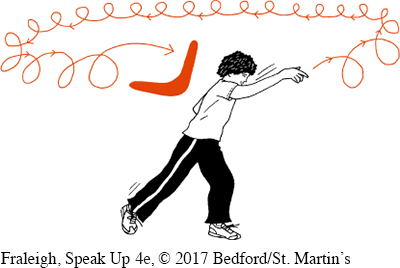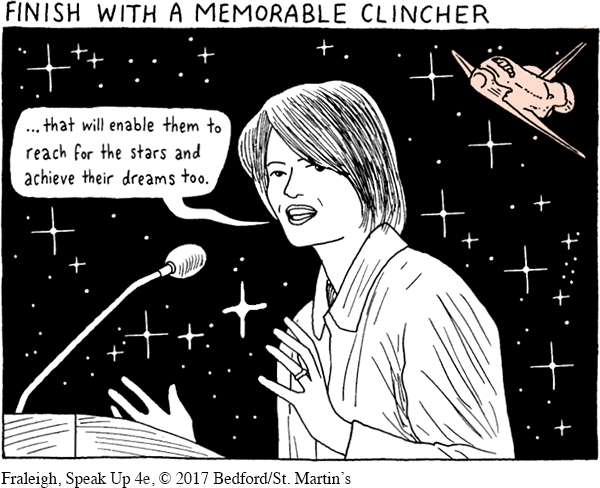Finish with a Memorable Clincher
Finish your conclusion with a clincher—something that leaves a lasting impression of your speech in your listeners’ minds. After your speech ends, audience members will have countless demands on their time and attention. To make your presentation memorable, select and word your clincher carefully.
The clincher should take only about thirty seconds in a five-
Page 296
Tie Your Clincher to the Introduction. If you began your speech with a compelling anecdote or example, consider extending it in your clincher. One speech asking audience members to serve as volunteer tutors began with the story of Hector, a twelve-
Remember Hector, the boy who was on the verge of dropping out in sixth grade? Ana, a student at this university, became his tutor and role model. Today, Hector has a B average in high school and has applied to several colleges. There are many more Hectors in our local schools, and your help as a tutor will make sure that there is a happy ending to their stories, too.

End with a Striking Sentence or Phrase. There may be a single sentence or phrase that effectively sums up your speech. Advertisers and political campaign managers often use this technique because the words are easy to remember. For example, an advertiser refers to a product as “the one,” or a campaign manager describes his candidate as possessing “the right stuff for the job.” We do not recommend ending your speech with a trivial phrase or a catchy tune. However, do consider using memorable, relevant phrasing to conclude your speech.

Page 297
A speech about Hmong history effectively concluded with a theme that had been evident in each main point:
The word Hmong means “free.” And no matter what continent we are living on, that is what we will always be—
Page 298
Also, consider Manal al-
The struggle is not about driving a car. It is about being in the driver’s seat of our destiny.8
Highlight Your Thesis. Rather than summing up your speech with a single key sentence, you may decide to use a few lines to reinforce the heart of your message. Consider an example from Sally Ride, the first American woman in space (she was awarded a posthumous Presidential Medal of Freedom in 2013). After ending her career as an astronaut, Dr. Ride became a dedicated advocate for improving math and science education for kids. Here is how she concluded her speech “Shoot for the Stars”:
Page 299
When I was a little girl, I always dreamed of flying in space. And amazingly enough (I still cannot believe it to this day), that dream came true for me. Now it is up to all of us to ensure that this generation of students in school today has access to a high-

Conclude with an Emotional Message. Recall a speech or presentation that ended by appealing to your emotions. If you’re like most people, that speech affected you more than a speech that used only cold hard facts. Often, a clincher that delivers an emotional charge makes a speech particularly memorable—
Page 300
My mind flooded with memories—
End with a Story or an Anecdote. A story that illustrates the message of your speech can make an effective clincher. Consider the following anecdote about Albert Einstein that a student used as her clincher in a speech advocating greater efforts to raise students’ self-
Over one hundred years ago, there was a boy who was considered “backward” by his teachers. They said the boy was mentally slow and adrift forever in his foolish dreams. His father said that when he asked the headmaster what profession his son should adopt, he was told, “It doesn’t matter; he’ll never make a success of anything.”10
Who was that hopeless student? Believe it or not, his name was Albert Einstein.
We must never give up on the mind of a child. Educators must convince every student that he or she is valued and capable of learning. Even one dropout is unacceptable.
To see an example of a clincher in a speech about college instructors, try Video Activity 10.3, “Clincher: Evokes Response.”